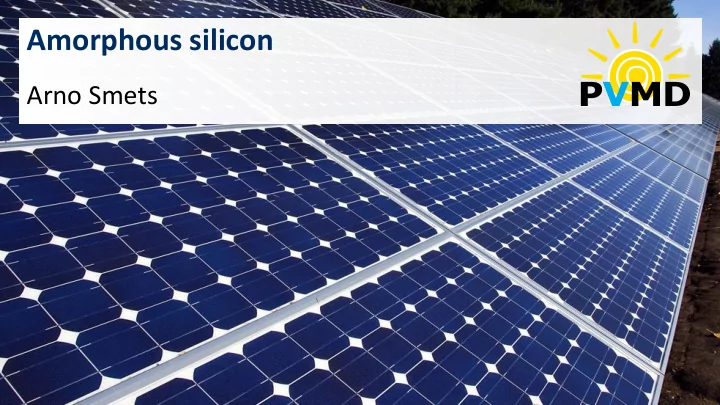

Amorphous silicon PVMD Arno Smets Delft University of Technology
Learning objectives • What is amorphous silicon • What are the different types of defects in a-Si • How does the amorphous structure affect the material properties
Source: www.youtube.com/watch?v=OyVUmucwhPo
Amorphous silicon Hydrogenated Single crystal silicon amorphous silicon a-Si :H Defect density: 10 12-14 cm 3 c-Si 10 19 cm 3 a-Si 10 16 cm 3 a-Si:H Si atom Covalent bond Unpassivated dangling bond Hydrogen passivated dangling bond
Defects in a-Si:H
Band diagram E Conduction band E C Band gap E G E V Valence band
Band diagram E mob =1.8 eV direct E G =1.1 eV indirect g V g C g(E) Valence Conduction band tail band tail Defect states E E V,mob E V E C E C,mob
Band diagram E mob =1.8 eV direct E G =1.1 eV indirect c-Si: Indirect bandgap E G =1.1 eV g V g C g(E) a-Si: Direct bandgap conduction E mob =1.8 eV band tail Defect states E E V,mob E V E C E C,mob
Absorption coefficient Wavelength (nm) 2480 1240 827 620 496 413 c-Si: Absorption coefficient (cm -1 ) 10 5 Indirect bandgap E G =1.1 eV 10 4 10 3 c-Si a-Si: 10 2 Direct bandgap a-Si 10 1 a-Si E mob =1.8 eV c-Si 10 0 0.5 1.0 1.5 2.0 2.5 3.0 Photon energy (eV)
c-Si a-Si Indirect bandgap Direct bandgap E G =1.1 eV E mob =1.8 eV E mob E G g V g C g(E) g g(E) g C g V V E E C,mob E E V E C E V,mob
Recommend
More recommend